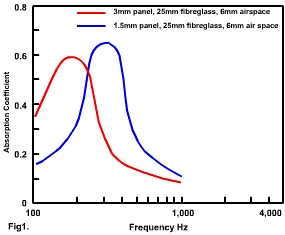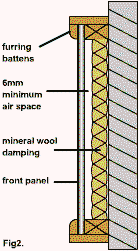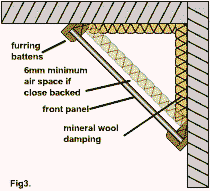DIY Bass Trap Basics
DIY Bass Trap Basics
Acoustic membranes, wood or plasterboard sheet can be very effective at the absorption of low frequency sound especially in small spaces where studwalls can often be built from them.
These walls will act as bass absorbers and so should be taken into account when constructing a studio of this type.
Any sheet material will resonate at a particular frequency depending on the relationship between the mass of the material and the distance it is spaced from a solid surface.
This resonant frequency can be calculated by dividing 60 by the square root of the panel mass (in kg/m²) multiplied by the distance from the wall in metres.

Simply put, the heavier the panel and/or the deeper the air space behind, the lower the resonant frequency of absorption will be.
If mineral wool is included in the cavity space behind then the frequency band over which the absorber will work will be widened.
E.g. our VL-65 acoustic membrane securely fixed over a frame of the following depths will absorb as follows:
- 110Hz @ 50mm.
- 90Hz @ 75mm.
- 77Hz @ 100mm.
- 55Hz @ 200mm.
Fig. 1 shows how plywood sheet performs when used in this manner. If the plywood were substituted for soundproofing mat or plasterboard, which has a greater mass, the resonant frequency would be lower.

E.g. 12.5mm plasterboard on 75mm studwork will resonate at around 63Hz. Two sheets of 12.5mm plasterboard will resonate at around 50Hz also over a 75mm cavity.
Obviously the problem with rooms built from studwork is that as a large amount of surface area is taken up with effectively a ‘uniform depth bass absorber’ which will have substantial bass absorption but only in a particular frequency range.
This may or may not be convenient to you. In a masonry walled room the bass reflections will be that much stronger and you will almost certainly be in the need for a large amount of low frequency absorption areas if you want a clean sound.
Fig. 2 shows a simple single depth absorber. It is essential that the mineral wool behind the panel does not touch the front panel. This would cause panel vibrations to be damped down.

Bass frequencies tend to collect in the corners of a room. Consequently, in a small room where space is at a premium it is best to place Bass Traps in the wall or ceiling corners.
This also makes the maximum use of the extra depth available and because an angled panel, across a corner, has a varying cavity depth the frequencies that are absorbed will be even wider than those of a constant depth absorber.

Fig. 3 shows a simple corner mounted panel absorber. It is essential that the mineral wool behind the panel does not touch the front panel. This would cause the panel vibrations to be damped down.
Most of our acoustic absorption and diffusion products will absorb substantially more low frequency sound if they are mounted away from the walls or across the corners of a room.
Quarter wavelength bass trap
Probably the most efficient bass absorber is the quarter wavelength trap. This is a large, absorbent cavity which has a depth relative to the frequency in question.
The outer face and the inner damping act together in a pumping effect which makes the traps extremely efficient especially at the lowest frequencies where wavelengths are extremely large.
The energy is reduced by the movement of the hanging heavy baffles.
VL65 acoustic membrane is an ideal limp barrier material for this application. Ideal if bonded to suspended timber panels.
Plasterboard on studs
Many small studios use plasterboard on studs to provide for the inner shell. This can, in some situations, be a cause of concern with respect to low frequency absorption.
There is limited test data available on the degree of absorption due to this construction but it can be significant. It may provide too much absorption at around 125Hz.
A commonly available figure is that one layer of 12.5mm plasterboard provides an absorption coefficient of approximately 0.29 at 125Hz when fixed to 100x50mm studs at 400mm centres. Whether noggins were included seems unclear.
What does seem clear, based on a research paper by J. S. Bradley for the J. Audio Eng. Soc., is that plasterboard layers on a 90mm metal stud can provide the following:
| Layers of 12.5mm plasterboard | 80Hz | 100Hz | 125Hz |
| 1 (no absorbent) | N/A | 0.40 | 0.29 |
| 2 (no absorbent) | 0.34 | 0.23 | 0.17 |
| 3 (no absorbent) | 0.24 | 0.17 | 0.14 |
| 4 (with absorbent) | 0.20 | 0.14 | 0.12 |
The data demonstrates that large surface area coverage of plasterboard on studs could potentially provide significant acoustic absorption which may well need to be included in further acoustical calculations to get a good neutral sounding room.
Miscellaneous
It may also be worth noting that stuffing rockwool across, or triangle foam blocks in, the room corners could arguably be considered more of a deep porous wide band absorber as it wont be a tuned bass trap.
If there is a dip in one location there will be a peak at that same frequency in a different location.
When in phase signals combine they create a peak.
When out of phase signals combine they produce a dip.
There are other corners in a room that can often be overlooked – The wall ceiling junctions (its usually impractical to place anything on the floor/wall junctions).
Floor to ceiling reflections are also often overlooked due to space restrictions.
Most ceilings being 2.5m tall will produce problems around 70Hz and 140Hz (give or take).
We hope you found DIY bass trap basics useful.
